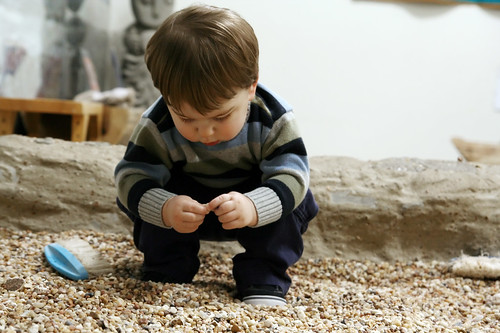“Learning to use the toilet is a process that takes time. Rather than push or manipulate your child by giving him treats such as candy or a special reward for something that he will learn to do on his own, trust that he will learn when he is ready. Respect is based on trust.” – Magda Gerber

Maybe you’ve heard the old adage,”You can lead a toddler to the potty but you can’t make him use it (until he’s ready).” During workshops for parents and toddler teachers I love to read the story, The Princess and the Potty by Wendy Cheyette Lewison, about a little princess who won’t use her potty,”because it doesn’t please her.” The king and queen are not happy with this and are a bit beside themselves as they worry about what their neighbors in the kingdom next door will say. They go out of their way to find a potty that will please the princess, to no avail. The princess simply has better things to do. So the king and queen try other tactics like reading to the princess, sending her teddy bear to keep her company, in fact, sending the whole court to keep her company, and even sitting on the potties themselves to show the princess what fun it is. Finally, not knowing what else to do, the king and queen send for the royal wise man to get his advice.
“If you ask me,” said the royal wise man, “the princess will use the potty when it pleases her to use the potty.”
But alas and alack, not even the royal wise man can predict when that time might come. So the king and queen wait and wait, until finally, one day the queen is dressing for a royal ball, and her daughter notices the beautiful pantalettes her mother is wearing and she decides the pantalettes please her. Of course, the queen, being the good Mom that she is, takes her little girl shopping the very next day to allow her to choose her own pantalettes, and the princess is so pleased, she wears the new panties home, and all through playtime, and snack time- when suddenly– the princess can’t sit still. The king and queen yell to the royal chambermaid that the princess needs her royal diaper, except the princess doesn’t want her royal diaper because that means she will have to take off her pretty new pantalettes, and this she doesn’t want to do, so she calls for her potty. While the royal servants run to get every potty in the castle, the princess takes matters into her own hands and runs to the plain potty, because it is the nearest, and that, in the end, is the potty that pleases the princess.
Like with sitting, standing, walking, and other accomplishments that involve a baby’s mastery over his body movements, when it comes to learning to use the toilet, the way loving adults can be most helpful is to provide an optimal environment, and then wait patiently for baby to be ready, and indicate her desire and willingness to participate in the process. The toilet learning process can sometimes cause parents needless worry and anxiety, and can feel endless to parents who are tired of changing diapers, or who are worried their child won’t be accepted at preschool unless she is toilet trained. (A good childcare center or preschool won’t require a child under the age of four to be potty trained, and I always advise parents to seek alternate care arrangements, if at all possible, should they encounter a program that requires potty mastery by the age of three.)
So what can you expect?
There is a wide range of normal, and while some toddlers may learn a bit earlier or later, the average child will reliably use the potty during the day somewhere between the ages of two and three years old, and will consistently stay dry at night somewhere between two and a half to five years old. Some children may happily and willingly use the toilet for a period of time, then decide they aren’t interested for awhile. This is perfectly acceptable, and it’s best if you can meet your child’s disinterest with a calm, matter of fact, “If you don’t want to/aren’t ready to use the potty, you may use a diaper.When you’re ready to try the potty again, let me know.” Learning to use the toilet is a complex process which requires a child to listen to his body signals, control his body, and understand the process, and what is expected and accepted. It involves physical readiness, or the ability to control the muscles that hold in bladder and bowel movements, cognitive readiness, or the ability to understand what is expected of him, and emotional readiness- this is all about holding on, letting go, and conforming to grown- up standards. It’s about who is in control, and in this case, it’s your child!
If you expect and accept that it will take time for your child to master this new skill, it can go a long way towards helping your child to “go with the flow,” so to speak. Stock up on training pants, be prepared for extra laundry, know where all the public rest rooms in town are, (because children can’t wait long when they are just learning, and inevitably, they will have to use the toilet fifteen minutes after you’ve left the house). Carry extra underwear, wipes, and a change of clothes with you at all times. Some parents even choose to carry a portable potty chair with them on long trips. If an accident happens, try to remain calm, matter of fact, and supportive. “Your pants are wet. Can I help you get cleaned up and into dry clothes?” “Accidents happen sometimes when you’re just learning to use the potty.You tried really hard to get to the potty on time. Next time, you’ll be able to do it.”
How do you know if it might be the right time to start the process with your child?
First, there should be no other big changes happening at home. It’s usually best not to start the process if a new baby has just arrived, you are moving in two weeks, or your child has just started childcare. Changes in the family, or stress can make the process more difficult and prolonged than it has to be. Summer time can be a great time to start, because family schedules are often more relaxed, and children can be allowed to run around naked or just in underwear at home, which helps them become very aware of what’s happening with their bodies (in a way they don’t when they are wearing super absorbent diapers or pull ups). If your child is in childcare or you have a caregiver at home, it’s a good idea for you all to have a discussion and maintain clear communication, to make sure you’re all on the same page and using a consistent approach and language when it comes to to toilet learning. (I’ll never forget the time when I was a new teacher’s aide, and one little girl, who was very soft spoken, and about five years old, tried urgently to communicate she had to use the bathroom, by whispering to me she had to “make.” I had never heard the expression before, and while I was trying to figure out what she was saying, she had an accident. She was mortified, and I felt so bad for not being able to understand and help her when she needed me to.)
Your child may indicate readiness to start potty learning when s/he:
1) Stays dry for 2-3 hours at a time or wakes up from a nap with a dry diaper.
2) Shows increased awareness of bodily functions- she may move to a quiet or private spot to have a bowel movement, for instance.
3) Tells you she has peed or pooped in her diaper.
4) Dislikes staying in wet or soiled diapers.
5) Shows interest in wanting to sit on a toilet or potty chair or expresses a desire to wear underwear.
6) Is able to follow two step instructions.
7) Is able to pull pants up and down easily.
Besides being prepared by knowing what to expect, watching for signs of readiness, and relaxing and trusting that your child won’t go to kindergarten in diapers, you can encourage your toddler’s interest and support her learning by:
1) Bringing your child’s awareness to what’s happening with his body and how he might know he may need to stop playing and go to the toilet. Use correct terms for body parts and body functions, and maintain a neutral tone. If your child is showing readiness, and you notice him pressing his legs together or dancing about, you can say, “It looks like you might have to go to the bathroom. Do you want to use your potty chair?”
2) Being a good model. Show your toddler how you use the toilet. Most toddlers become fascinated with the toilet and what happens there, long before they’re ready to use it themselves.
3) If your child is expressing that they don’t like to have their diapers changed, or they don’t like to sit in a wet diaper, you can offer, as I have been with 34 month old J. as of late, “You don’t like feeling wet and cold. You don’t like to get your diaper changed. If you wanted to, you could put your pee in the potty, and then you wouldn’t have to have your diaper changed.” So far, he says “Not yet, Lisa. Maybe later,” which I completely accept. But in the past three weeks he has started to ask to sit on his potty when his six year old sister goes to the bathroom. He’s had several successes, and he’s just so proud. Last week he came running to show me he “peed in the potty just like the boy in the book!” Beware insisting upon or cajoling your child to sit on the potty if it’s not her idea. You may offer at natural times, for instance, when your child is preparing for a bath, but if she says “No,” let it be “No.” Let him “practice” in his own way. Some children like to sit on the potty fully clothed for many months before ever taking off their diapers.
4) Dress for success. Pants with elastic waists are best for both girls and boys- easy for them to pull up and down by themselves. No dresses to get in the way, no buttons, snaps, belts, overalls, etc.
4) Read a book with your child about using the toilet. Two of my favorites: Once Upon A Potty by Alona Frankel, and Going To The Potty (First Experiences), by Fred Rogers.
5) Let him choose his very own potty chair. Potty chairs are great, because they let your child sit with his feet firmly planted on the floor, which assists in bowel movements. They also allow your child to be in charge of their process- I’ve never known a child who didn’t love to participate in pouring the contents of their potty into the toilet, then wave goodbye and flush it away. (Remember, young children are sometimes very attached to their bodily fluids. Children are not born with any negative associations when it comes to bodily functions, they are taught to think that urine and feces are “yukky” or “stinky” or “disgusting” or somehow shameful.) Some children are afraid of sitting on the toilet with it’s big gaping hole, even if a child size seat is installed. If you are going to use one of the seats that sits on the top of the regular toilet, make sure you place a step stool beneath your child’s feet so she can climb up by herself and her legs aren’t dangling when she sits.
6) Let him choose training or underpants. My feeling is that pull ups give a mixed message, and don’t help a child learn, because they are too much like a diaper, yet, some parents feel they can’t do without them- they like that their child can pull them up and down like underwear, and it saves on wet clothes, and laundry. I’d prefer a child wear training pants or a diaper, if at all possible.
7) Remember, this process is your child’s. You can’t do it for her. You can’t hurry her along. Time and maturation can make the process a painless one (for both of you) if you allow it to be so. The natural reward for your child is the mastery she feels at accomplishing a new skill and body control.
For those of you who have asked me for information and my opinion about elimination communication, I will refer you to an excellent discussion at Janet Lansbury’s community forum, where I, and others weigh in with our ideas and experiences on the topic.
There you go, my best advice when it comes to potty learning. Have I missed anything?


